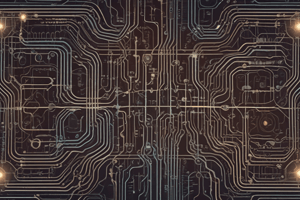Podcast
Questions and Answers
What happens to the overall current in a series circuit when additional loads are added?
What happens to the overall current in a series circuit when additional loads are added?
In a parallel circuit with two identical bulbs connected, how does the potential difference across each bulb compare to the source?
In a parallel circuit with two identical bulbs connected, how does the potential difference across each bulb compare to the source?
If one bulb in a series circuit fails, what will happen to the other bulbs?
If one bulb in a series circuit fails, what will happen to the other bulbs?
What is true about current in a series circuit when multiple loads are present?
What is true about current in a series circuit when multiple loads are present?
Signup and view all the answers
How does the voltage across each bulb in a series circuit relate to the total voltage supplied?
How does the voltage across each bulb in a series circuit relate to the total voltage supplied?
Signup and view all the answers
In a parallel circuit, if one branch is removed, what occurs in the remaining branches?
In a parallel circuit, if one branch is removed, what occurs in the remaining branches?
Signup and view all the answers
When calculating total resistance in a series circuit with two loads of 10 Ω each, what is the total resistance?
When calculating total resistance in a series circuit with two loads of 10 Ω each, what is the total resistance?
Signup and view all the answers
What effect does adding additional loads to a parallel circuit have on the total current drawn from the source?
What effect does adding additional loads to a parallel circuit have on the total current drawn from the source?
Signup and view all the answers
In a circuit with both series and parallel components, which rule applies regarding voltage and current?
In a circuit with both series and parallel components, which rule applies regarding voltage and current?
Signup and view all the answers
Flashcards
Series Circuit: Current Flow
Series Circuit: Current Flow
In a series circuit, the current has only one path to flow through all components. Imagine a single lane highway where all cars must follow the same route.
Series Circuit: Voltage Division
Series Circuit: Voltage Division
Components connected in series share the total voltage from the source. As you add more components, the voltage available for each individual component decreases.
Parallel Circuit: Current Flow
Parallel Circuit: Current Flow
In a parallel circuit, the current has multiple paths to flow. Imagine a multi-lane highway where cars can take different routes.
Parallel Circuit: Voltage Distribution
Parallel Circuit: Voltage Distribution
Signup and view all the flashcards
Series Circuit: Bulb Brightness
Series Circuit: Bulb Brightness
Signup and view all the flashcards
Parallel Circuit: Bulb Brightness
Parallel Circuit: Bulb Brightness
Signup and view all the flashcards
Series Circuit: Open Circuit
Series Circuit: Open Circuit
Signup and view all the flashcards
Parallel Circuit: Open Circuit
Parallel Circuit: Open Circuit
Signup and view all the flashcards
Series Circuit: Total Resistance
Series Circuit: Total Resistance
Signup and view all the flashcards
Parallel Circuit: Total Resistance
Parallel Circuit: Total Resistance
Signup and view all the flashcards
Study Notes
Series Circuits
- In series circuits, there is only one path for current flow.
- Total resistance increases as more loads (e.g., light bulbs) are added.
- Voltage across each load decreases with addition of loads.
- If one load fails, the entire circuit is broken.
- Each load acts as a resistor, affecting the overall current.
Parallel Circuits
- Parallel circuits have multiple paths for current flow.
- The voltage across each load is the same as the source voltage.
- Total current through the circuit is the sum of currents through all branches.
- Loads operate independently. If one load fails, the others remain functional.
- Voltage is constant across each parallel branch, sum of currents equals total current coming out of source.
Studying That Suits You
Use AI to generate personalized quizzes and flashcards to suit your learning preferences.
Related Documents
Description
This quiz tests your understanding of series and parallel circuits. Learn the key differences in current flow, resistance, voltage, and the impact of load failure in each type of circuit. Perfect for electronics students or anyone interested in electrical principles.




